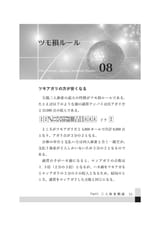Search Results
6/16/2025, 10:50:51 AM
>Chapter 8
>Tsumo loss
I'm going to summarise this chapter because it's just basic sanma rules.
Because there are only two other players in sanma, you get less points on tsumo than you do with ron (assuming equal han/fu). The key takeaways in the chapter are the following:
1. Dealer only gets 2/3 of the "actual" hand value on tsumo.
2. Consequently, a dealer mangan ron is the same value as a dealer haneman tsumo.
3. Dealer baiman tsumo is worse(!) than dealer haneman ron.
4. Calling riichi with a mangan or better hand as dealer is not good because the value upgrade can be nullified by tsumo loss.
5. Non-dealers get 3/4 of the "real" hand value.
6. For non-dealers, calling riichi becomes bad when the hand is haneman or better (haneman ron point gain = baiman tsumo point gain).
tl;dr Yonma can be said to be all about tsumo, but this is not true for sanma. There you want to ron if possible. This makes reading yamiten important.
>Tsumo loss
I'm going to summarise this chapter because it's just basic sanma rules.
Because there are only two other players in sanma, you get less points on tsumo than you do with ron (assuming equal han/fu). The key takeaways in the chapter are the following:
1. Dealer only gets 2/3 of the "actual" hand value on tsumo.
2. Consequently, a dealer mangan ron is the same value as a dealer haneman tsumo.
3. Dealer baiman tsumo is worse(!) than dealer haneman ron.
4. Calling riichi with a mangan or better hand as dealer is not good because the value upgrade can be nullified by tsumo loss.
5. Non-dealers get 3/4 of the "real" hand value.
6. For non-dealers, calling riichi becomes bad when the hand is haneman or better (haneman ron point gain = baiman tsumo point gain).
tl;dr Yonma can be said to be all about tsumo, but this is not true for sanma. There you want to ron if possible. This makes reading yamiten important.
Page 1
